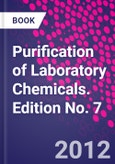A best seller since 1966, Purification of Laboratory Chemicals keeps engineers, scientists, chemists, biochemists and students up to date with the purification of the chemical reagents with which they work, the processes for their purification, and guides readers on critical safety and hazards for the safe handling of chemicals and processes. The Seventh Edition is fully updated and provides expanded coverage of the latest commercially available chemical products and processing techniques, safety and hazards: over 200 pages of coverage of new commercially available chemicals since the previous edition.
Table of Contents
Chapter 1. Common Physical Techniques Used in Purification
Chapter 2. Chemical Methods Used in Purification
Chapter 3. The Future of Purification
Chapter 4. Purification of Organic Chemicals
Chapter 5. Purification of Inorganic and Metal-Organic Chemicals
Chapter 6. Catalysts
Chapter 7. Purification of Biochemicals and Related Products
Chapter 8. Nanomaterials and Nanotechnology








